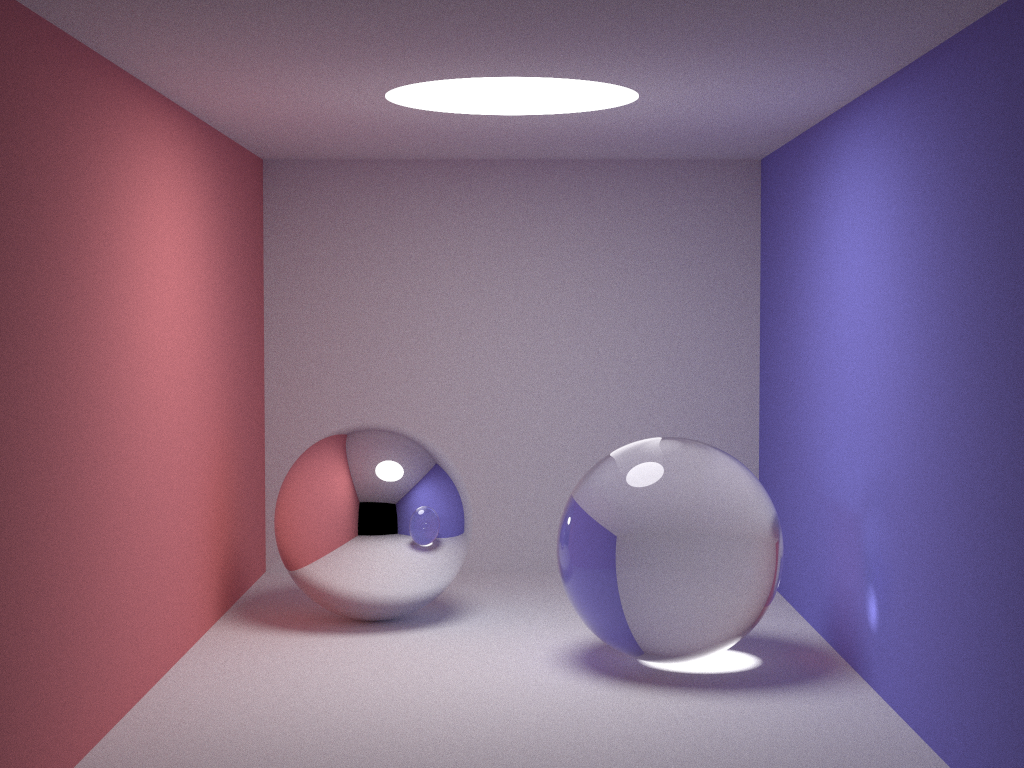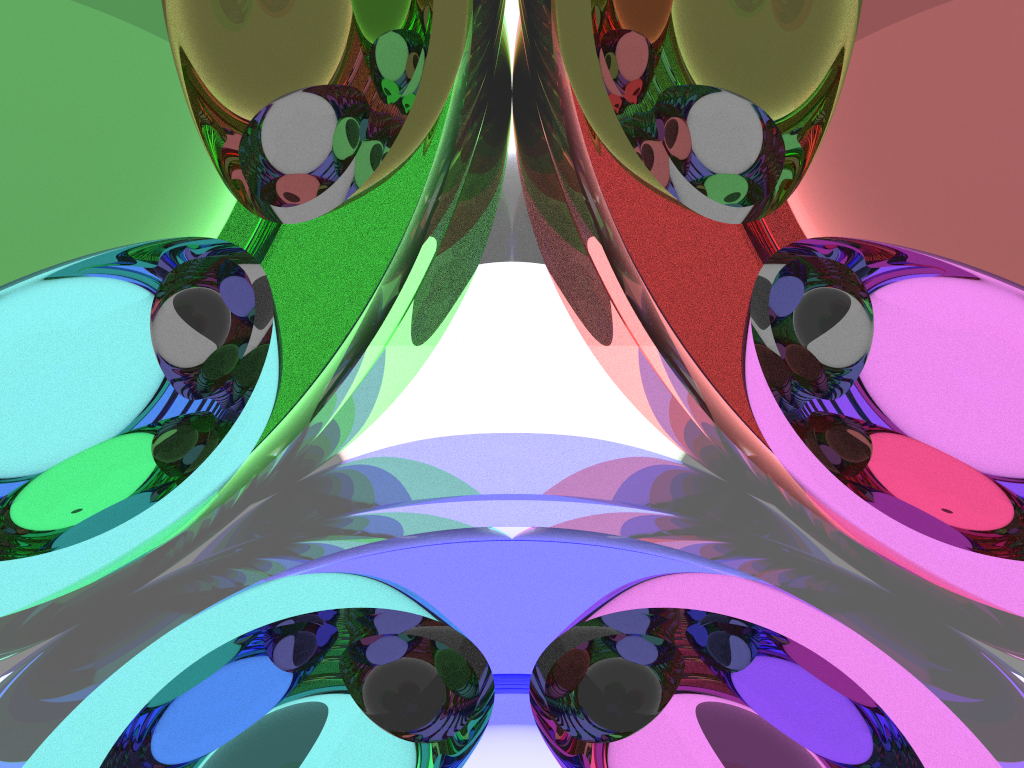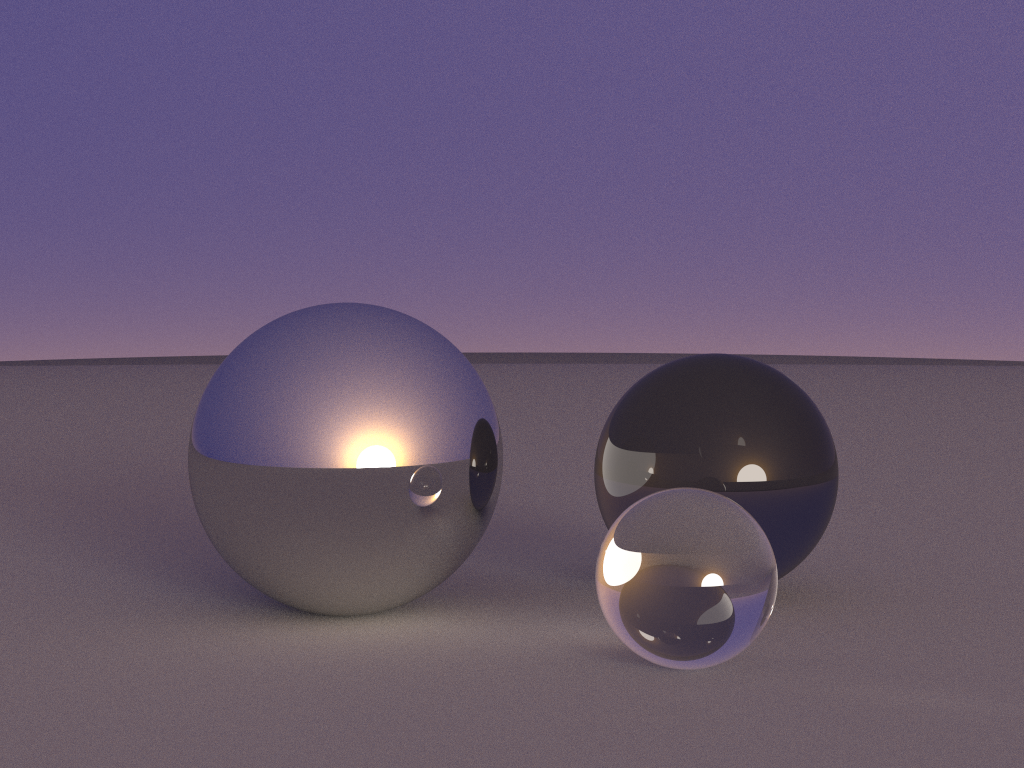Radium is a small and lightweight Ray Tracing Engine written in C++ that runs on the CPU using shared-memory multiprocessing.
-
Simple and easy-to-use API.
-
Global illumination using Unbiased Monte Carlo Path Tracing.
-
Soft shadows from Diffuse Light Sources.
-
Specular, Diffuse, and Refractive Materials are supported.
-
Total Internal Reflection for Refractive Materials.
-
Russian Roulette for path termination.
-
Radium has been tested on MacOS and Linux. Support for Windows is Experimental via WSL.
-
git clone --recursive https://github.com/soumik12345/Radium -
sh ./install.sh linuxin order to install the python dependencies. For MacOs, use argumentmac. -
Make sure you have CMake installed for your system.
-
Edit to include the engine code
src/main.cpp. -
sh ./build_and_run.sh
Rendering a Cornell Box is considered a standard benchmark for a rendering system. The basic environment consists of:
- One light source in the center of a white ceiling
- A green right wall
- A red left wall
- A white back wall
- A white floor
We will try to add two more objects, a DIFFUSE and a REFRACTED object.
#include "Radium.h"
int main() {
// Step 1: Create an instance of the Radium Renderer
Renderer renderer(1024, 768, 5000); // Parameters -> Frame Width, Frame Height, Samples per Pixel
// Step 2: Set the position and direction of the Renderer Camera
renderer.setCameraPosition(50, 50, 295.6); // Set Position of the Renderer Camera
renderer.setCameraDirection(0, -0.042612, -1); // Set Direction of Renderer Camera
// Step 3: Create the Scene by placing Spherical Objects
// Parameters for Sphere -> Radius, Position, Emission, Color, Material
renderer.addObject(
Sphere(1e5, Vector3(1e5 + 1, 40.8, 81.6), Vector3(), Vector3(.75, .25, .25), DIFFUSE)); // Left Wall
renderer.addObject(
Sphere(1e5, Vector3(-1e5 + 99, 40.8, 81.6), Vector3(), Vector3(.25, .25, .75), DIFFUSE)); // Right Wall
renderer.addObject(
Sphere(1e5, Vector3(50, 40.8, 1e5), Vector3(), Vector3(.75, .75, .75), DIFFUSE)); // Back Wall
renderer.addObject(
Sphere(1e5, Vector3(50, 40.8, -1e5 + 170), Vector3(), Vector3(), DIFFUSE)); // Front Wall
renderer.addObject(
Sphere(1e5, Vector3(50, 1e5, 81.6), Vector3(), Vector3(.75, .75, .75), DIFFUSE)); // Bottom Floor
renderer.addObject(
Sphere(1e5, Vector3(50, -1e5 + 81.6, 81.6), Vector3(), Vector3(.75, .75, .75), DIFFUSE)); // Top Ceiling
renderer.addObject(
Sphere(16.5, Vector3(27, 16.5, 47), Vector3(), Vector3(1, 1, 1) * .999, SPECULAR)); // Shiny Surface Ball
renderer.addObject(
Sphere(16.5, Vector3(73, 16.5, 78), Vector3(), Vector3(1, 1, 1) * .999, REFRACTED)); // Glass Ball
renderer.addObject(
Sphere(600, Vector3(50, 681.6 - .27, 81.6), Vector3(12, 12, 12), Vector3(), DIFFUSE)); // Light Source
// Step 4: Render the Scene
renderer.render(true); // Parameter -> Flag to turn on Progressbar or not
// Step 5: Export the Scene and Camera Settings to CSV files
// These CSV files can be parsed by renderer.importCamera and renderer.importWorld methods
renderer.exportWorld("cornell_box_world.csv");
renderer.exportCamera("cornell_box_camera.csv");
return 0;
}This gives us the following result:
This took 100 minutes to render on Intel Core i5 8th Gen.
You can also render a scene from the exported CSV files as shown below,
#include "Radium.h"
int main() {
Renderer renderer(1024, 768, 40);
renderer.importCamera("../scenes/cameras/demo_4_camera.csv");
renderer.importWorld("../scenes/worlds/demo_4_world.csv");
renderer.render(true);
return 0;
}
-
Radium supports only spherical objects, other shapes are not supported. In order to render flat surfaces, we can use a sphere with a large radius and place the camera close to it, so that the curvature of the surface is not noticeable.
-
If you are using build_and_run.sh, make sure that your world file ends with
world.csvand camera file withcamera.csv. -
By default, the World settings are exported at
./scenes/worlds, the camera settings are exported at./scenes/camerasand the rendered image is exported at./dumpin both ppm and png format. -
Radium achieves parallelism in the computation using an OpenMP
#pragmato dynamically allocate rows of the image to different threads for each processor or core. Hence, if you have openmp installed on your system, it would significantly increase the rendering speed. -
Rendering time increases with increase in samples per pixel. Rendering at lower samples per pixel however increases black dot artifacts.
| Frame Dimensions | Number of Objects | Samples per Pixel | Processor | Render Time |
|---|---|---|---|---|
| (1024, 768) | 7 | 5000 | Intel Core i5 8th Gen | 91 Miniutes |
| Frame Dimensions | Number of Objects | Samples per Pixel | Processor | Render Time |
|---|---|---|---|---|
| (1024, 768) | 5 | 40 | Intel Core i5 8th Gen | 2 Minutes |
| Frame Dimensions | Number of Objects | Samples per Pixel | Processor | Render Time |
|---|---|---|---|---|
| (1024, 768) | 7 | 200 | Intel Core i5 8th Gen | 4 Minutes |
| Frame Dimensions | Number of Objects | Samples per Pixel | Processor | Render Time |
|---|---|---|---|---|
| (1024, 768) | 9 | 5000 | Intel Core i5 8th Gen | 71 Minutes |
-
An improved illumination model for shaded display by Turner Whitted.
-
Data for constructing the demo images have been taken from the demos of Kevin Beason's smallpt




